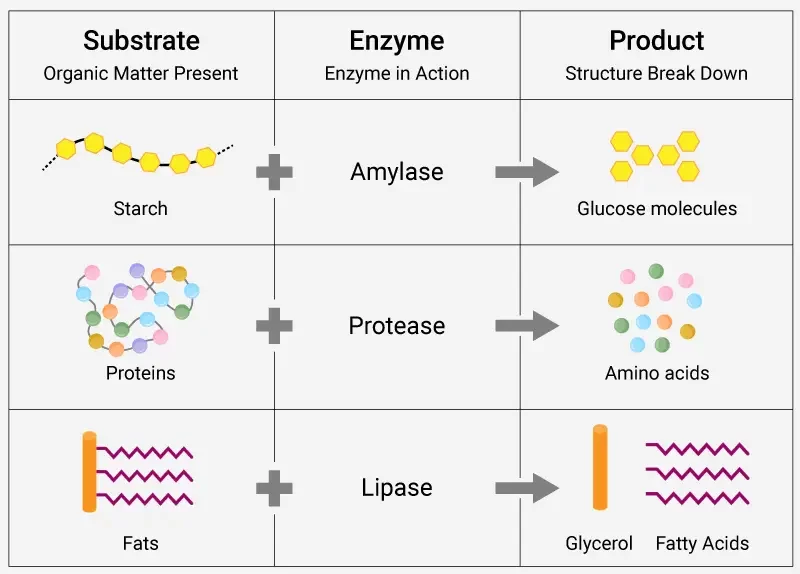Multi-enzyme cleaners harness the power of biological enzymes—specialised molecules that accelerate chemical reactions—to target and break down contaminants with precision, following a lock-and-key model where each enzyme fits a specific type of residue.
When sprayed onto a surface, these cleaners introduce beneficial bacteria that rapidly multiply and begin producing enzymes. These enzymes initiate the breakdown of organic matter, making cleaning both faster and more thorough.
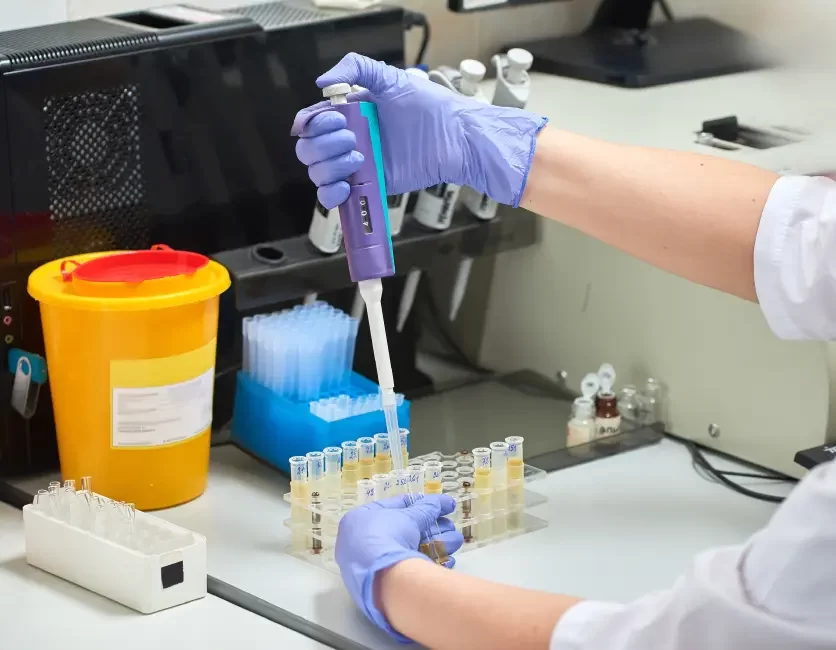
Image Credit : Shutterstock / al7
Thanks to their enzymatic action, these formulas outperform many traditional chemical cleaners. They provide rapid material degradation, are biodegradable, pH-neutral, and non-corrosive—making them ideal for HVAC and indoor environmental cleaning. Let’s explore how these powerful agents work and why they are the go-to solution for professional HVAC Hygiene companies like Clean-Air.
Benefits of Enzyme Cleaners
Enzymes are proteins composed of amino acid chains that function as catalysts. Through a “lock-and-key” mechanism, they break down organic substances—such as grease, stains, and odours—into smaller, manageable molecules that bacteria can then consume and digest. [1]
Key Advantages:
- Effective Stain Removal: Enzymes target and dismantle tough, organic-based stains that resist conventional cleaning methods.
- Odour Elimination: By breaking down the source of odours, enzyme cleaners neutralise unpleasant smells at their root.
- Eco-Friendly: Enzyme cleaners utilise natural, biodegradable processes, producing harmless byproducts like water and carbon dioxide.
- Safer: Free from harsh chemicals, these cleaners are safe to use in homes and sensitive environments.
How Enzyme Cleaners Work
Enzyme-based cleaning products provide a five-step biological approach to breaking down organic matter:
- Enzymes as Catalysts
Enzymes accelerate chemical reactions without being consumed or altered during the process. - Targeted Action
Specific enzymes are designed to target proteins, fats, and carbohydrates—the main constituents of organic debris and stains. - Beneficial Bacteria
Many enzyme cleaners include bacteria that consume the smaller organic molecules created by enzymatic breakdown. - Digestion Process
The bacteria digest these remnants, converting them into harmless byproducts like CO₂ and water. - Complete Odour and Stain Elimination
By removing the root causes, enzyme cleaners provide long-lasting cleanliness and odour control.
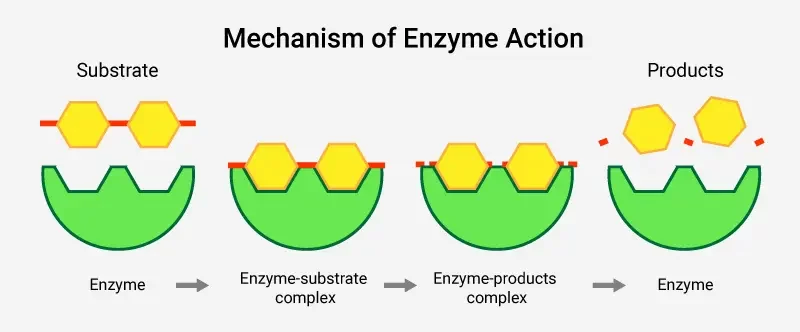
The Lock-and-Key Model: How Enzymes Function
Enzyme-substrate interaction is often explained by the lock-and-key model. Each enzyme contains an active site—the "lock"—shaped to fit a specific substrate—the "key." This model ensures that each enzyme acts only on particular types of organic matter, enhancing both precision and efficiency. [2]
This specificity is crucial in multi-enzyme cleaners, where various enzymes work in tandem to break down different types of contaminants, such as proteins, starches, and fats.

Common Enzymes and Their Roles
| Enzyme | Target Substance | Application Example |
|---|---|---|
| Amylases | Starches | Food and Drink Stains |
| Lipases | Fats and Oils | Grease, oily residues |
| Cellulases | Cellulose (soil, dust) | Organic debris from soil and plant matter |
| Proteases | Proteins (urine, blood) | Bodily fluids, food stains |
| Mannanases | Plant-based polysaccharides | Organic residue in HVAC biofilms and dirt layers |
Enzyme Chemistry in HVAC Coil Cleaners
The enzyme-based coil cleaner we use has a combination of enzymes and beneficial bacteria to tackle organic contaminants commonly found in HVAC systems. When sprayed onto a coil surface, the bacterial culture quickly multiplies and secretes enzymes that break down biofilm, mould, and other biological build-ups.
Typical Formula Components:
- Detergents (for surface tension reduction)
- Proteases
- Amylases
- Lipases
- Cellulases
- Mannanases
A synergistic blend offers a broader and more powerful cleaning spectrum than single-enzyme products.

Image Credit : Shutterstock / IBRAHIMOZKADIR
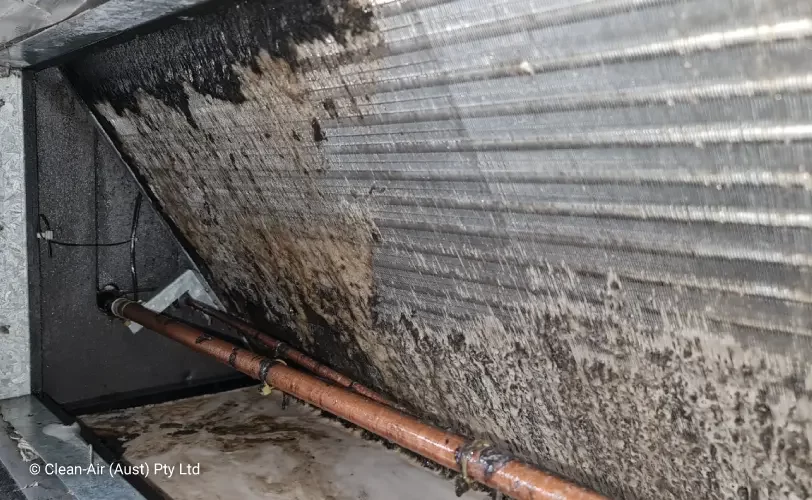
Pre Cleaning
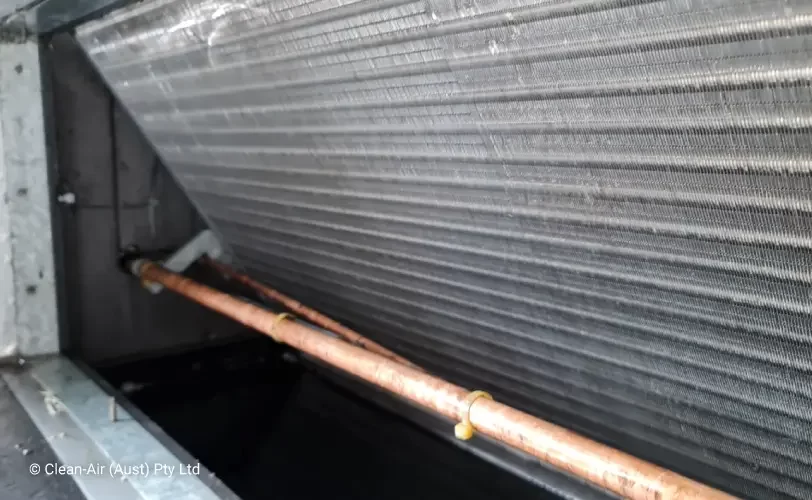
Post Cleaning
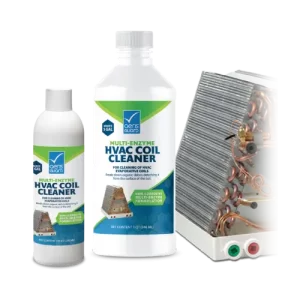
AerisGuard™ Multi-Enzyme Coil Cleaner [3]
- Non-corrosive, compatible with all metal surfaces
- Suitable for domestic, commercial & industrial air installations
- Compatible with all common cleaning processes
- Odour free, easy to use
- Biodegradable
Pure Enzyme Functions
- Protease
Function: Breaks peptide bonds in proteins. These can be derived from plants, microbes, or animals and are used across acidic to alkaline environments. - Lipase
Function: Targets and deconstructs fats. Often included in laundry and surface cleaners for grease and oil removal. - Endocellulase
Function: Assists in removing stains from grass, blood, fat, and similar substances through cellulose degradation. - Alpha-Amylase
Function: Breaks down starch into smaller sugars. Commonly used in both laundry and dishwashing detergents.
These enzymes act repeatedly without being consumed, making them both efficient and cost-effective.
Enzymes + Probiotics: A Synergistic Solution
Why Combine Them?
Using enzymes and probiotics together creates a powerful and long-lasting cleaning effect:
- Enzymes begin the process by breaking down complex organic matter.
- Probiotics (beneficial microbes, typically Bacillus species) feed on the resulting smaller molecules, such as amino acids, fatty acids, and sugars.
How It Works:
| Phase | Action |
|---|---|
| Enzymatic | Enzymes catalyse the breakdown of complex materials |
| Microbial | Probiotics consume the breakdown products, continuing the cleaning |
| Long-Term Impact | Beneficial microbes remain active, inhibiting pathogen regrowth and re-soiling |
Together, they not only clean effectively but also help maintain cleaner surfaces for longer periods by establishing a healthy microflora.
Conclusion
Understanding the biological principles behind enzymatic cleaners reveals why they are a powerful, sustainable, and effective solution for a wide range of cleaning challenges. At Clean-Air, we rely on our trusted chemical partner, Aeris Environmental, to supply premium multi-enzyme cleaning solutions tailored for HVAC and indoor environmental hygiene.
By leveraging the science of enzymes and probiotics, we ensure deep cleaning, long-term protection, and safer environments for our clients.
References
[1] National Library of Medicine – Biochemistry of Proteins and Enzymes https://www.ncbi.nlm.nih.gov/books/NBK554481
[2] Berg, J.M., Tymoczko, J.L., & Stryer, L. (2002). Biochemistry (5th ed.) – National Center for Biotechnology Information
“In the lock-and-key model, the enzyme and the substrate possess specific complementary geometric shapes that fit exactly into one another.”
[3] Aeris Environmental – HVAC Coil Cleaner – AerisGuard https://aeris.com.au/shop/hvac-r/hvac-coil-cleaner-aerisguard
Arrange a meeting with our team, as an Aeris Environmental platinum partner we have the products and services to preserve your HVAC investment and restore Indoor Air Quality. Get in touch here
![]()
Related: Environmental IAQ Testing Under the Microscope
Environmental testing for microbial contamination involves a range of sampling methods designed to assess potential contaminants in indoor spaces.
Related: What is Particulate Matter (PM)?
When understanding Air Quality standards you’ll see acronyms such as PM2.5 being used. These are classifications of Particulate Matter

